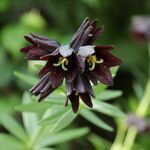A bulb plant. It grows 25-40 cm high and 10-15 cm wide. The leaves are arranged in rings or whorls around the stems. The leaves are glossy green. They are sword shaped. The flowers occur as 2 or 3 on a stem. The flowers are bell-shaped and nearly black purple.

